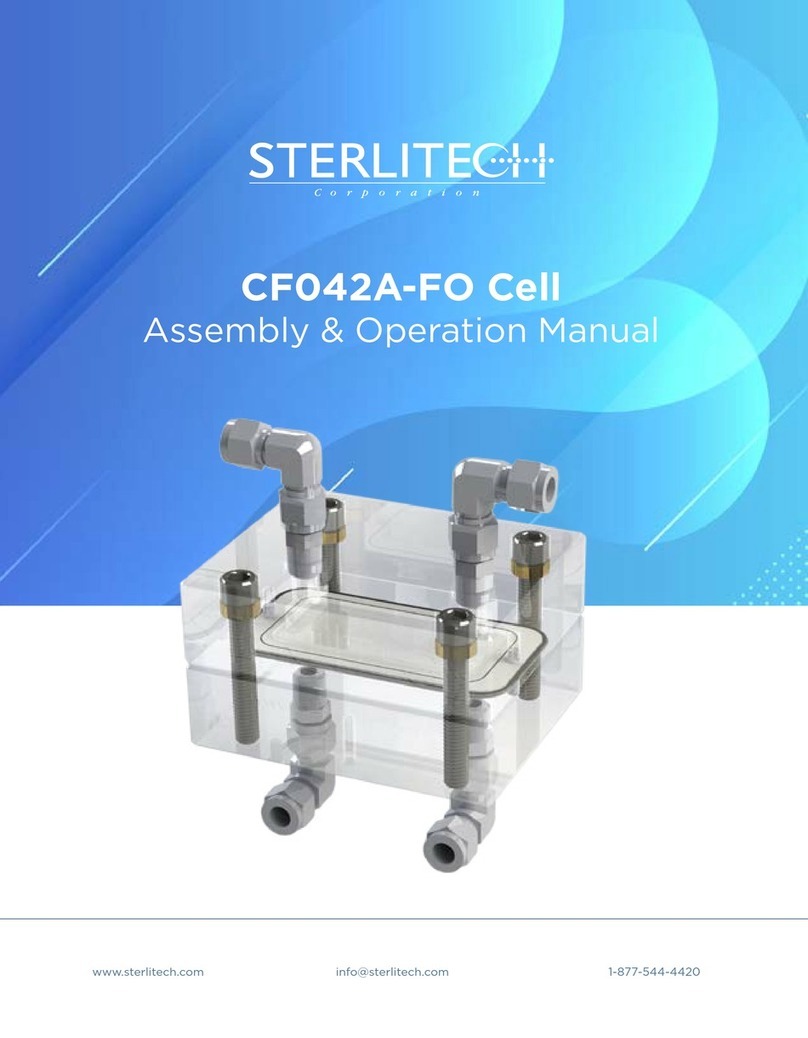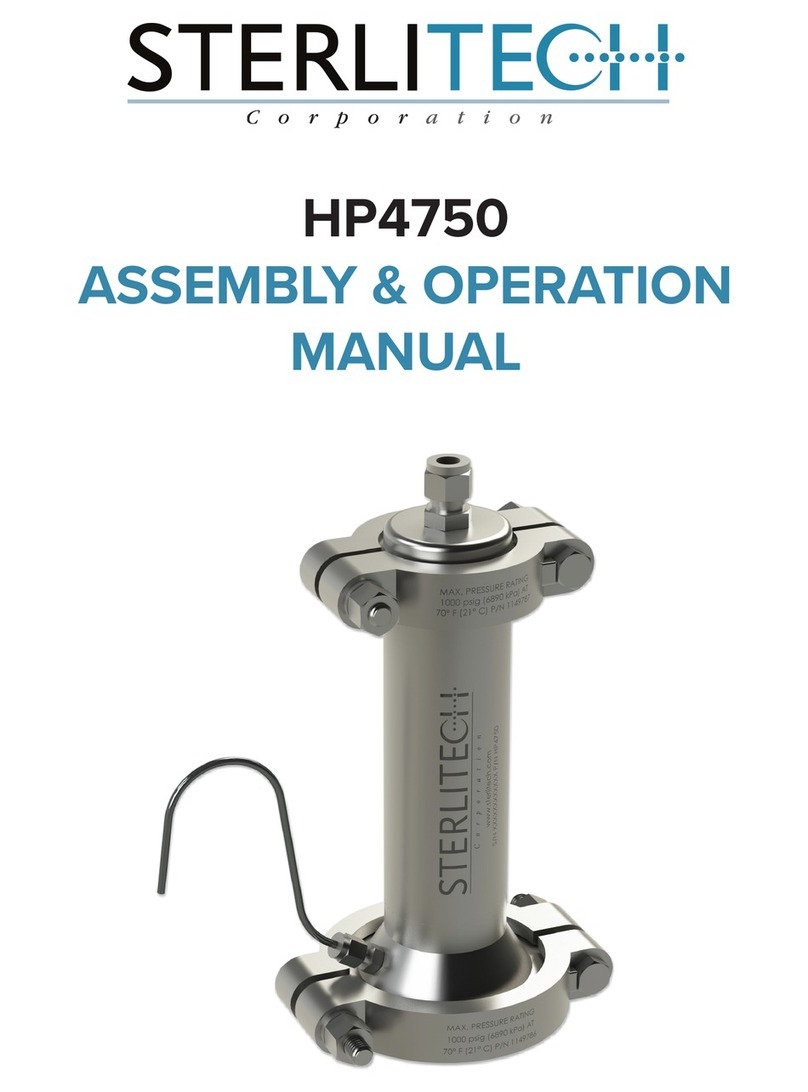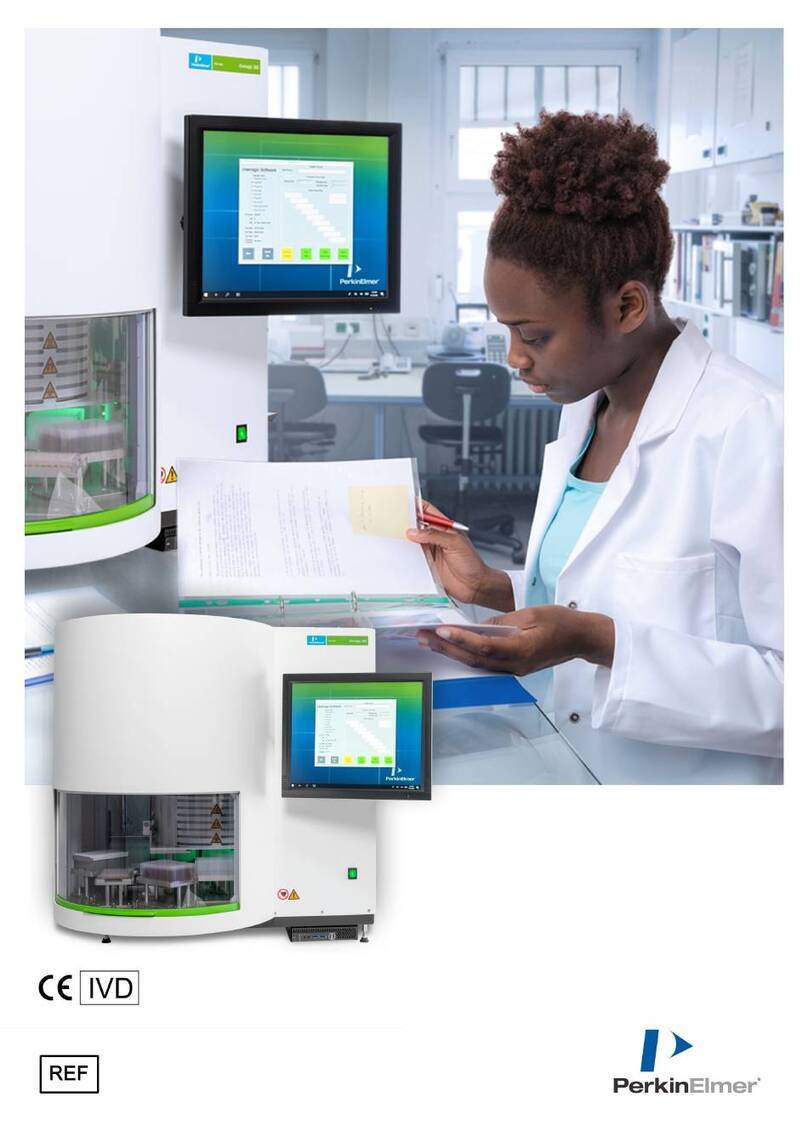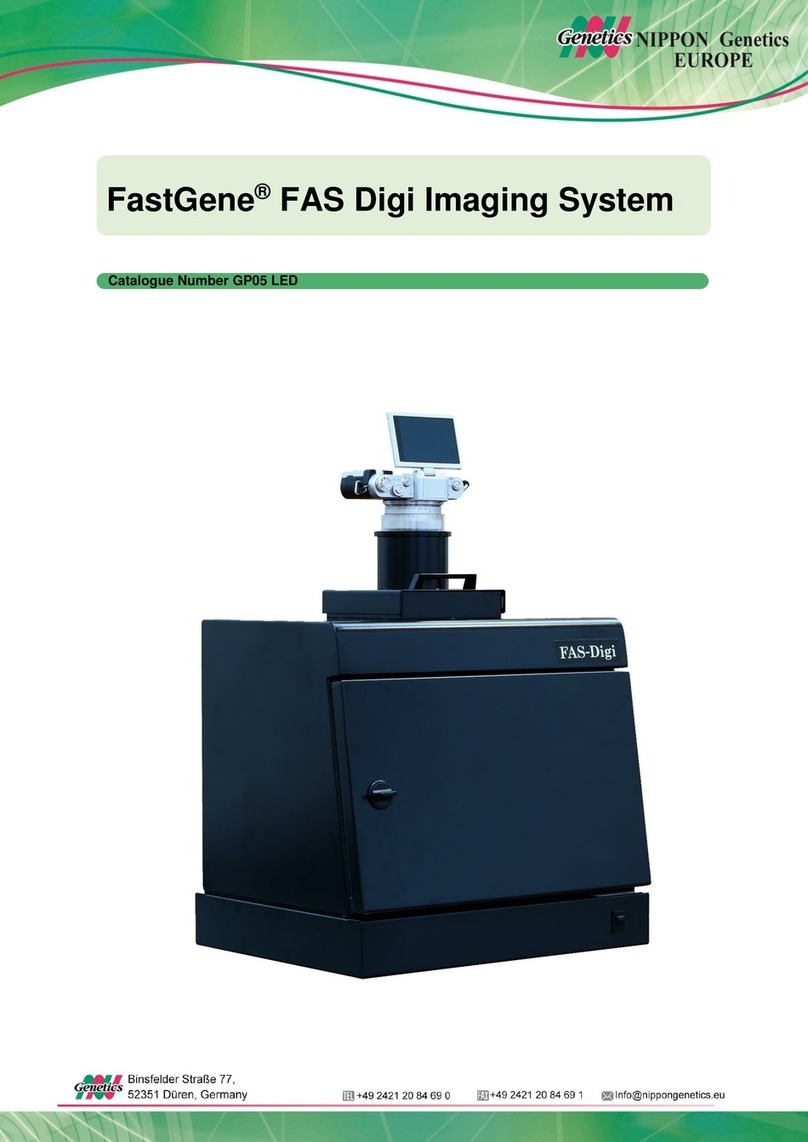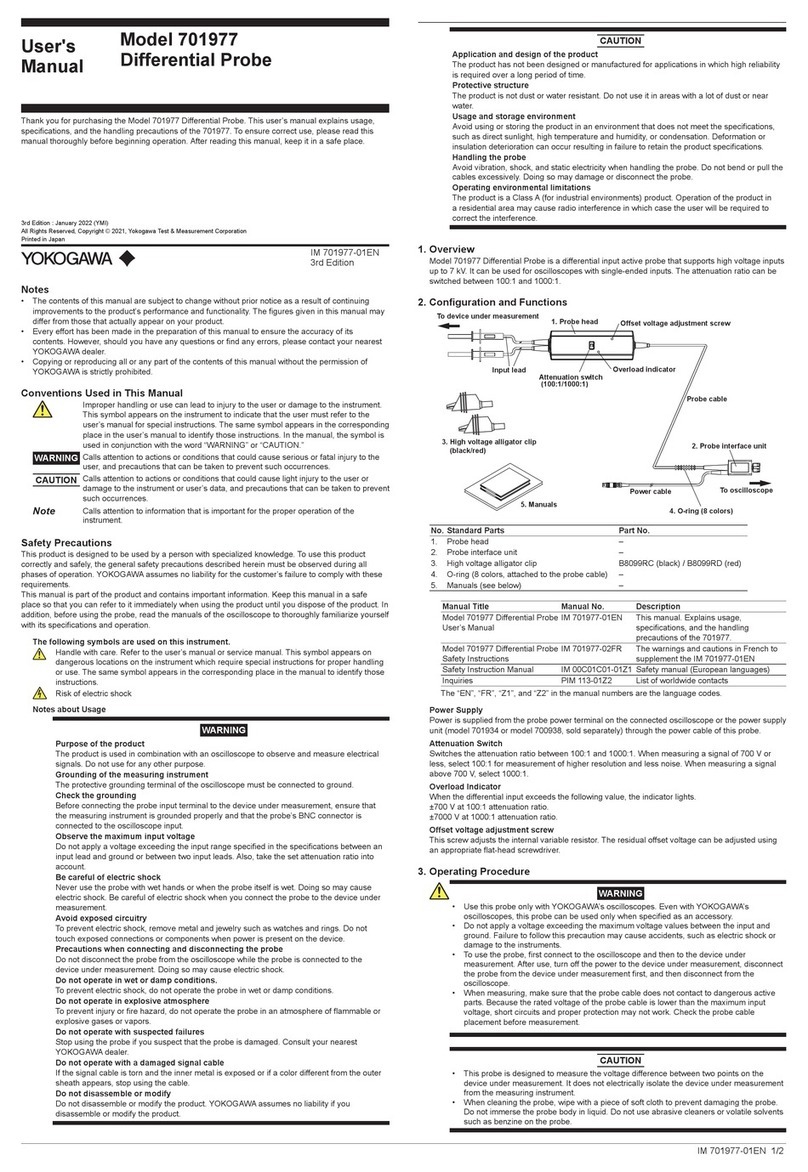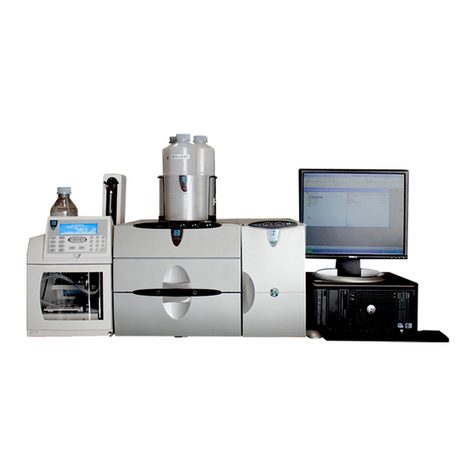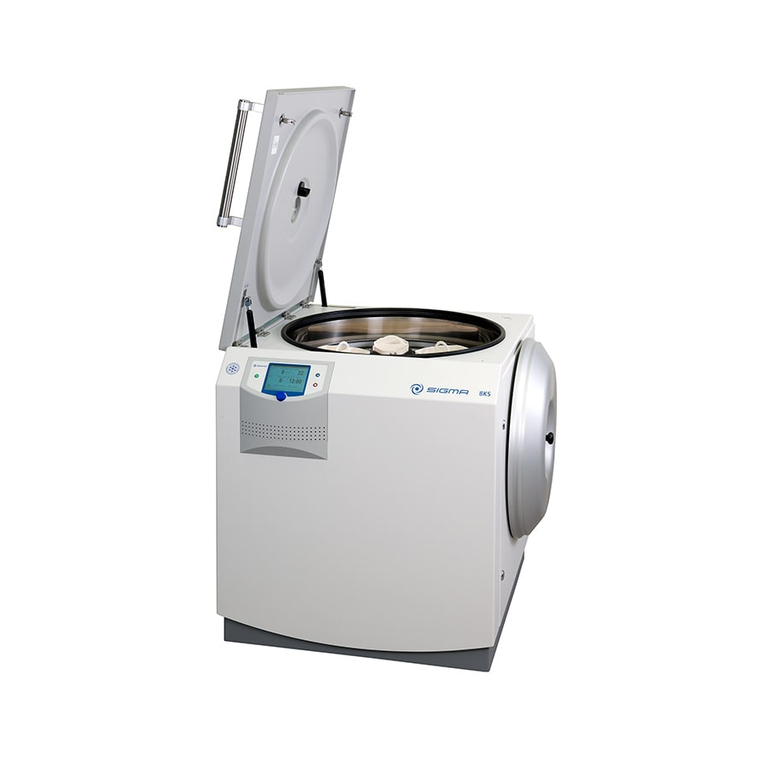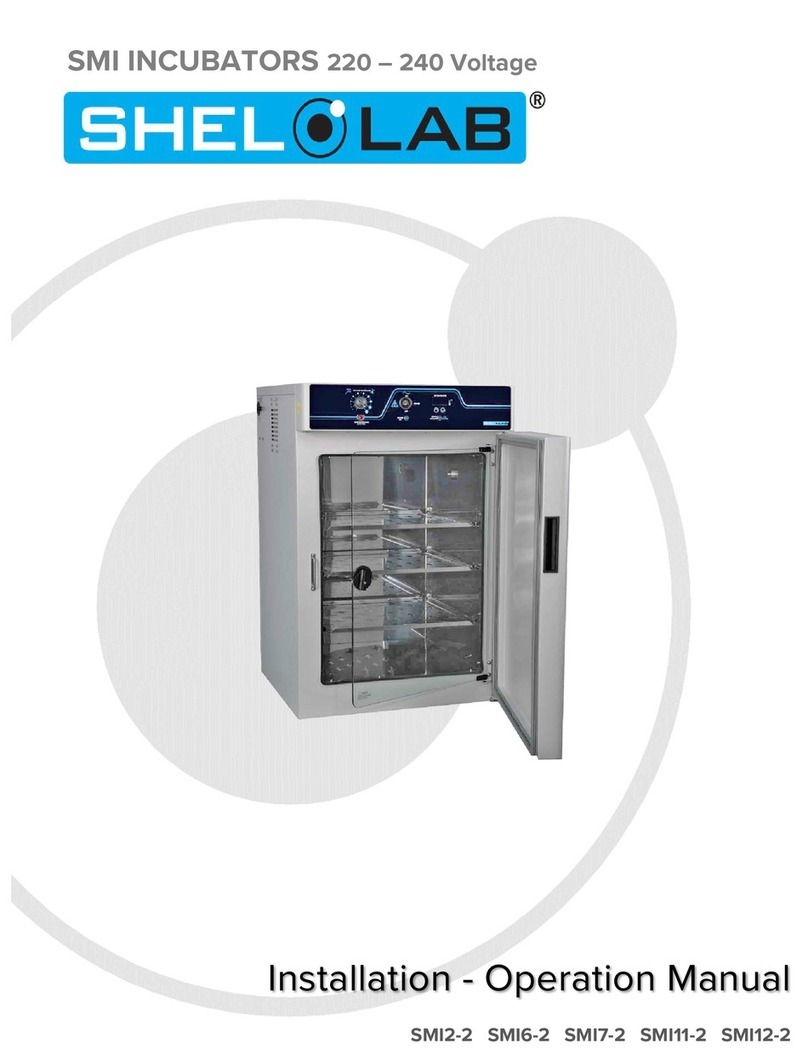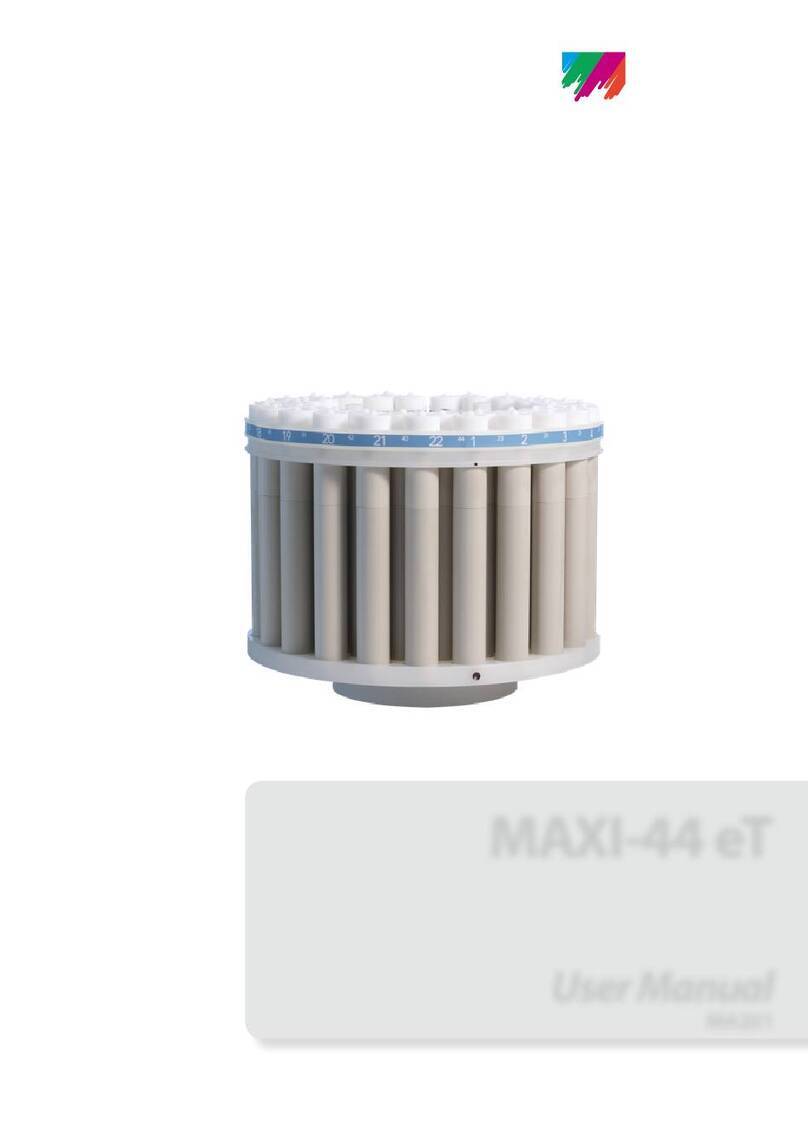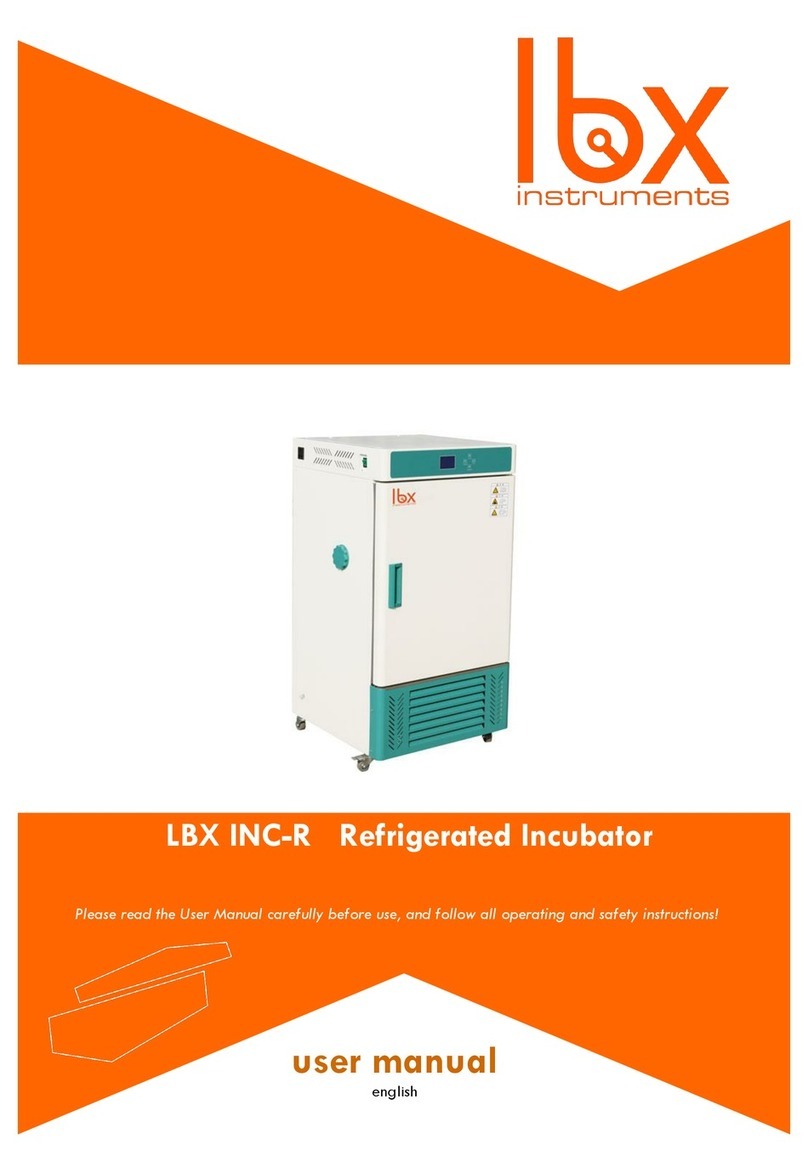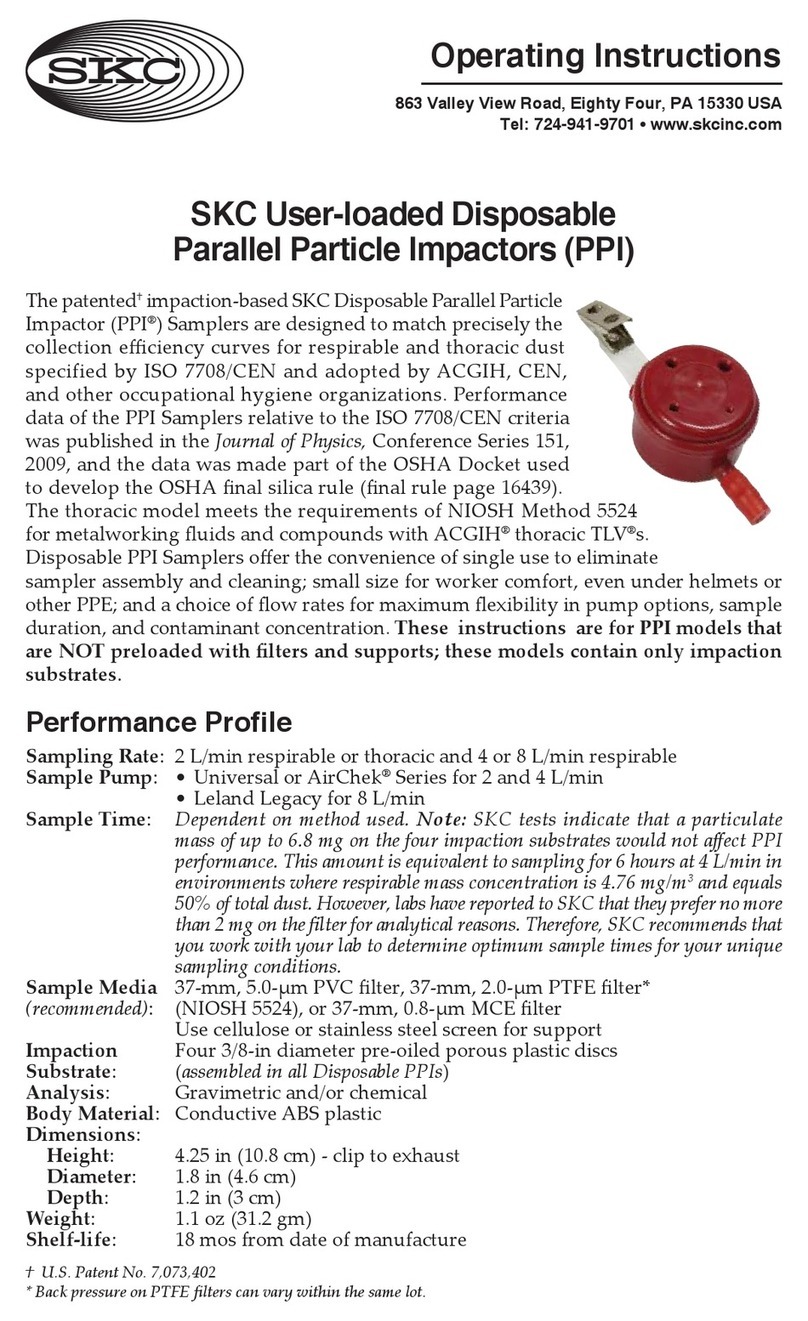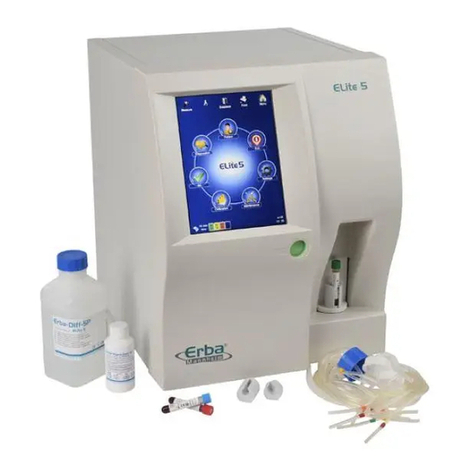Sterlitech 1812 Supplement

1812 Spiral Wound Membrane
High Pressure Housing
Assembly & Operation Manual
www.sterlitech.com 1-877-544-4420info@sterlitech.com

www.sterlitech.com 1-877-544-4420info@sterlitech.com
Table of Contents
2
3
5
10
12
14
15
15
15
16
19
12
Page
1. Introduction
3. 1812 Housing Assembly
7. Accessory and Spare Part Ordering Information
2. 1812 Housing Components
5. Operation of the 1812 Housing Assembly
4. 1812 Housing Assembly Connections and Parts
6. Supplementary Operating Information
8. Return Material Authorization
9. Warranty
10. Technical Assistance
Appendix 1: Compression Connections
Appendix 2: Bench Scale Filtration Products

2
1812 Spiral Wound Membrane High Pressure Housing Manual
www.sterlitech.com 1-877-544-4420info@sterlitech.com
The 1812 Spiral Wound Membrane Housing is a bench-scale crossflow filtration system that is designed
to evaluate 1812 spiral wound membrane elements in a variety of applications. It simulates the flow
dynamics of commercially available spiral wound membrane elements. Users can vary the operating
conditions and fluid dynamics over broad ranges.
Table 1 below outlines the features and technical specifications of the 1812 Spiral Wound Membrane
Housing (hereafter referred to as 1812 Housing).
Prior to operating or servicing this device, this manual must be read and understood.
1. Introduction
Parameter Description
Membrane Active Area
Maximum Pressure
Cross Flow Velocity
Inlet/Outlet/Permeate connection
Variable (1 to 5 ft2)
SS316
60 bar (870 v psig)
Variable
Gasket
Tube Length
Viton (Other materials available)
374.6 mm (14.75 inches)
9.3 mm (0.365 inches)
48 mm (1.88 inches)
1812 Housing
Maximum Temperature
Dimensions
200°C (400 °F)
pH Range
Tube ID
Membrane Dependent
Table 1: 1812 Housing Features and Technical Specification

1812 Spiral Wound Membrane High Pressure Housing Manual
www.sterlitech.com 1-877-544-4420info@sterlitech.com
3
The 1812 housing consists of the following components. Figure 1 illustrates a typical
assembly of the 1812 Housing.
Figure 1: 1812 Housing Assembly
Legend:
1. Stainless Steel 316 housing
2. 3/8 inchgaskets for top and bottom end caps
3. 2.5 inch gasket for permeate tube
4. Top end cap
5. Bottom end cap
6. 2.5 inch Tri clamp fittings
7. 1/2 inch Tri clamp fitting
8. 3/8 inch ferrule, connection
3
5
7
7
7
4
86
6
1
2
3
2. 1812 Housing Components

4
1812 Spiral Wound Membrane High Pressure Housing Manual
www.sterlitech.com 1-877-544-4420info@sterlitech.com
Operation of the 1812 housing cell requires additional equipment that are sold
separately as listed below. To inquire about a complete system, contact
sales@sterlitech.com.
• Feed Pump
• Feed Tank
• 1812 Spiralwound Membrane Elements
• Concentrate Control Valve
2.1. Additional Equipment

1812 Spiral Wound Membrane High Pressure Housing Manual
www.sterlitech.com 1-877-544-4420info@sterlitech.com
5
After verifying that all of the necessary components were shipped and present, you can begin
the assembly of the system.
To assemble the 1812 Element into the housing:
To remove the 1812 Element from the housing:
1. Close the longer end of the permeate tube of the membrane module (the end without
the PTFE seal) using the compression connection (Figure 2, #1). Appendix 1 shows how to
install Swagelok Tube Fittings
2. Connect the hollow compression connection to the shorter end of the tube (the end with
the PTFE seal) (Figure 2, #2).
3. Connect the hollow end cap to the hollow compression connection (Figure 3#1)
4. Insert the membrane module in the housing starting from the close end of the permeate
tube (Figure 4, #1,2)
Note: make sure the gasket (Figure 1, #3) is in place before connecting the top end cap to
the tube
5. Use the tri clamp fitting to secure the hollow end cap (Figure 4, #3)
6. Place the solid end cap on to the other side of the element and secure it using the tri
clamp fitting. (Figure 5, #1,2)
7. Connect the feed inlet, retentate outlet and permeate outlet houses using the clamps
NOTE: Feed inlet should be connected to the side of the housing where top end
cap is connected and the retentate outlet tubing should be connected to the side
where the end cap is connected
The 1812 Housing is now assembled and ready to be connected to a feed pump for
operation.
WARNING: Do not exceed 870 psi (60 bar) in the 1812 Housing.
1. Remove the clamp and open up hollow end cap.
2. Remove the element by pulling the element through the hollow end cap.
3. Separate the element from the hollow end cap.
3. 1812 Housing Assembly

6
1812 Spiral Wound Membrane High Pressure Housing Manual
www.sterlitech.com 1-877-544-4420info@sterlitech.com
Figure 2: Connecting compression fittings (Swagelok tube fittings) to the
module permeate tubes
Legend:
1. Permeate line compression fitting, solid
2. Permeate line compression fitting, solid
3. 1812 element
1
3
2

1812 Spiral Wound Membrane High Pressure Housing Manual
www.sterlitech.com 1-877-544-4420info@sterlitech.com
7
Figure 3: Connecting the top end cap
Legend:
1. Top End Cap
2. Compression Fitting
1
2

8
1812 Spiral Wound Membrane High Pressure Housing Manual
www.sterlitech.com 1-877-544-4420info@sterlitech.com
Figure 4: 1812 Element insertion into the housing
Legend:
1. 1812 male element
2. Top End Cap
3. Tri clamp fitting
1
23

1812 Spiral Wound Membrane High Pressure Housing Manual
www.sterlitech.com 1-877-544-4420info@sterlitech.com
9
Figure 5: Bottom End Cap
Legend:
1. Bottom End Cap
2. Sanitary Fitting on Bottom End Cap
3. 3/8-inch gaskets for bottom end cap
1
3
2

10
1812 Spiral Wound Membrane High Pressure Housing Manual
www.sterlitech.com 1-877-544-4420info@sterlitech.com
1
2
3
5
6
4
7
11
A
A
B
C
D
9
10
8
1812 FLOW DIAGRAM
ITEM NO.
PART DESCRIPTION
1
FEED TANK
2
PRESSURE RELIEF VALVE
3
FEED PUMP
4
FEED BY-PASS VALVE
5
FEED BY-PASS FLOW METER
6
FEED PRESSURE GAUGE
7
1812 HOUSING
8
CONCENTRATE CONTROL VALVE ASSEMBLY, (0-1000PSI)
9
CONCENTRATE FLOW METER
10
PERMEATE FLOW METER
11
PERMEATE TANK
A
3/8" HIGH PRESSURE TUBING, FEED LINE
B
3/8" LOW PRESSURE TUBING, BY-PASS
C
3/8" LOW PRESSURE TUBING, RETURN LINE
D
3/8" LOW PRESSURE TUBING, PERMEATE OUTPUT LINE
Figure 6: 1812-HP Housing Assembly Connections and Parts
1812 Flow Diagram
Item No.
4
8
Part Description
Feed By-Pass Valve
Concentrate Control Valve Assembly, (0-1000 PSI)
2
6
10
B
Pressure Relieve Valve
Feed Pressure Gauge
Permeate Flow Meter
3/8” Low Pressure Tubing, By-Pass
1
5
9
A
Feed Tank
Feed By-Pass Flow Meter
Concentrate Flow Meter
3
7
11
C
D
Feed Pump
1812 Housing
Permeate Tank
3/8” Low Pressure Tubing, Return Line
3/8” High Pressure Tubing, Feed Line
3/8” Low Pressure Tubing, Permeate Output Line

1812 Spiral Wound Membrane High Pressure Housing Manual
www.sterlitech.com 1-877-544-4420info@sterlitech.com
11
Figure 6 shows the typical plumbing connections that are needed for the operation of the
1812 Housing; the configuration can change slightly depending on the objectives ofthe user.
In general, the connections needed are as follows:
1. Feed vessel to the pump inlet
2. Pump outlet to the feed inlet of the 1812 housing
3. Concentrate outlet of the 1812 housing to the feed vessel
4. Permeate collection tube to the permeate collectionvessel
Figure 6 also lists the additional components that are necessary to operate the 1812
Housing. These components are sold separately and can be found in the Membrane/ Process
Development section of the Sterlitech website (http://www.sterlitech.com/membrane-
process-development.html). The final assembly of the system will vary with the feed vessels,
pumps, and tubing used.

12
1812 Spiral Wound Membrane High Pressure Housing Manual
www.sterlitech.com 1-877-544-4420info@sterlitech.com
4. Operation of the 1812 Housing Assembly
5. Supplementary Operating Information
5.1. Membrane Performance Results
5.2 Membrane Performance
Once the 1812 Housing has been assembled and connected to a feed pump, it can be used
in reverse osmosis, ultrafiltration, nanofiltration, and microfiltration separation processes
for applications in a variety of industries, including food and beverage, pharmaceutical, or
industrial.
To operate the 1812 Housing Assembly:
1. Open all of the valves in the system to relieve any pressure build-up before turning on
the feedpump.
2. Turn the feed pump on.
3. Set the feed pressure to be less than 600 psig by gradually closing the concentrate
control valve (Figure 6,8) (sold separately).
4. Verify the feed pressure reading on the concentrate pressure gauge (sold separately)
(Figure 6, 8).
5. Adjust the bypass valve (Figure 6, 4) and concentrate control valve (Figure 6, 8) to
obtain the desired pressure and ow. Experimentation enables you to determine the
optimum settings for pressure, and flow rate to use on the chosen membrane and the fluid
being processed.
6. Once the experiment is complete, shut down the system by turning the feed pump o and
opening all of the valves to relieve any pressure buildup.
Spiral wound membranes containing mesh spacers are usually operated with a fluid velocity
across the membrane surface of 0.1–0.5 m/sec (0.3–1.6 ft/sec). Higher velocities in membranes
may lead to excessive pressure dierential across the membrane and possible damage.
Other parameters such as viscosity, pressure, and suspended solids may also aect
performance/operation. Experimentation with the 1812 Housing can help predict the best
operating parameters. If your pump is delivering too much flow, a portion of the flow can
be diverted back to the feed container before entering the feed inlet of the cell body. This
requires installation of an optional bypass valve and fitting on the pump outlet (Figure 6, 4),
which is not supplied with the housing.

1812 Spiral Wound Membrane High Pressure Housing Manual
www.sterlitech.com 1-877-544-4420info@sterlitech.com
13
5.3. Temperature Limits
5.4. Membrane Cleaning
The membranes, feed spacer, permeate, O-rings, and cell body materials construction dictates
maximum operating temperatures.
The 1812 housing can be cleaned easily after the membrane is removed. However, you may
wish to simulate the actual cleaning conditions of Cleaning-In-Place (CIP) in larger systems
with spiral-wound or tubular membranes. CIP chemically cleans without removing the
membrane to mechanically scrub the unit.
During CIP, cleaning solutions are re-circulated and, in some cases, allowed to sit for a period
of time within the cell body. In some cases, the feed pump can be used to re- circulate the
cleaning solutions.
Components Maximum Temperature
1812 Housing 177 °C (350 °F)
Variable
Viton 200 °C (400 °F)
150 °C (300 °F)
Membrane Elements
O-rings
EPDM
Table 2: Upper Temperature Limits

14
1812 Spiral Wound Membrane High Pressure Housing Manual
www.sterlitech.com 1-877-544-4420info@sterlitech.com
6. Accessory and Spare Part Ordering Information
Accessories and spare parts for the 1812 housing can be ordered by calling Sterlitech Corporation at
1-877-544-4420 or by visiting www.sterlitech.com.
Table 3: Accessory and Spare Part Ordering Information
Product
Spare Parts
Shipping Weight Ordering Number
1812 Housing, for operation to 60bar (870 psig)
2.5” Viton Gasket
Concentrate Control Valve
1812 Membrane Elements
4.67 kg (10.3 lbs)
Contact Sterlitech Contact Sterlitech
1200373
1230133
1149419
Contact Sterlitech
1200371
1230131
1180150
0.05 lb (0.028 kg)
2 lbs (0.9 kg)
Contact Sterlitech
2.5”EPDM Gasket 0.05 lb (0.028 kg)
Feed Flow Pump
1/2“ VitonGasket for Permeate Line 0.5 lbs (0.22 kg)
3/8“EPDMGasket for Permeate Line 0.5lbs (0.22 kg)

1812 Spiral Wound Membrane High Pressure Housing Manual
www.sterlitech.com 1-877-544-4420info@sterlitech.com
15
7. Return Material Authorization
8. Warranty
9. Technical Assistance
If materials are to be returned to Sterlitech for repair, evaluation, or warranty consideration, a Return
Material Authorization (RMA) number and form must be obtained from Sterlitech prior to the return.
Contact Sterlitech’s Customer Service Department for these forms.
The form must be completed and returned with the material. Be sure to include a complete, detailed
written reason for the return. Also, include serial numbers, installation and removal dates, and any other
pertinent information that is available. 1812 Housings have a serial number imprinted on the cell bottom.
Indicate the proposed disposition of the material, and reference the RMA number on all packages or
cartons. All material must be shipped to Sterlitech with freight prepared by the customer.
The following is made in lieu of all other warranties expressed or implied. Sterlitech Corporation
guarantees equipment to be free from defects in material and workmanship when operated in
accordance with written instructions for a period of one year from receipt. Parts not manufactured by
Sterlitech are covered by their manufacturer’s warranties, which are normally for one year.
Manufacturers and Seller’s only obligation shall be to issue credit against the purchase or replacement of
equipment proved to be defective in material or workmanship. Neither manufacturer nor seller shall be
liable for any injury, loss or damage, direct or indirect, special or consequential, arising out of the use of,
misuse, or the inability to use such product.
The information contained herein is based on technical data and tests, which we believe to be reliable,
and is intended for use by persons having technical skill at their discretion and risk. Since conditions
of use are outside Sterlitech’s control, we can assume noliability whatsoever for results obtained or
damages incurred through the application of the data presented.
This information is not intended as a license to operate under, or a recommendation to infringe upon,
any patent of Sterlitech or others covering any material or use.
The foregoing may not be altered except by a written agreement signed by ocers of the manufacturer.
Please contact us if you have any questions or technical inquiries about our products by calling
Sterlitech Corporation at 1-877-544-4420 or by visiting www.sterlitech.com.

16
1812 Spiral Wound Membrane High Pressure Housing Manual
www.sterlitech.com 1-877-544-4420info@sterlitech.com
Appendix 1: Compression Connections
To install Swagelok Tube Fittings:
1. Insert the tubing into the Swagelok tube fitting. Make sure that the tubing rests firmly on
the shoulder of the fitting and that the nut is finger-tight.
2. Scribe the nut at the 6 o’clock position. By scribing the nut at the 6 o’clock position as it
appears to you, there will be no doubt as to the starting position.

1812 Spiral Wound Membrane High Pressure Housing Manual
www.sterlitech.com 1-877-544-4420info@sterlitech.com
17
3. Hold the fitting body steady with a backup wrench and tighten the nut 1¼ turns. Watch
the scribe mark, make one complete revolution and continue to the 9 o’clock position.
When the nut is tightened to the 9 o’clock, you can easily see the fitting has been
tightened properly.
Swagelok connections can be disconnected and retightened many times.
To retighten the Swagelok connection:
1. Start with the disconnected fitting.

18
1812 Spiral Wound Membrane High Pressure Housing Manual
www.sterlitech.com 1-877-544-4420info@sterlitech.com
2. Insert tubing with pre-swaged ferrules into fitting body until front ferrule seats.
3. Tighten the nut by hand. Rotate nut to the original position with a wrench. An increase
in resistance will be encountered at the original position. Then tighten slightly with the
wrench.

1812 Spiral Wound Membrane High Pressure Housing Manual
www.sterlitech.com 1-877-544-4420info@sterlitech.com
19
Appendix 2: Sterlitech Bench Scale Filtration Products
Filter Holder
Membrane
Active Area
Typical
Permeate Flux
Typical
Permeate Flow
Rate (per Cell)
System
Capacity
Max. Pump
Capacity
Min. Batch
Volume (per
Cell)
Filtration
Mode(s)
Cell Material
Max Operating
Pressure
HP4750(X)
14.6 cm2(2.26in2)
30-300 LMH
(17.6-176 GFD)
1.5-15 mL/min
0.7-7L/day
(0.2-2 GPD)
N/A
300mL
Dead-End Stirred
Cell
SS316,HastelloyTM
HP4750: 69bar
(1,000 psi)
HP4750X: 172bar
(2,500 psi)
20.6 cm2(3.2in2)
30-300 LMH
(17.6-176 GFD)
1-10mL/min
1.5-15L/day
(0.4-4 GPD)
6.8 LPM (76 bar)
1.8 GPM (1,100 psi)
3.7 L(1gal)
Cross Flow, Forward
Osmosis
PTFE, Delrin,Acrylic,
SS316, HastelloyTM
PTFE, Delrin,Acrylic,
SS316, HastelloyTM
PTFE/Acrylic: 27.6
bar (400psi)
Delrin/SS316/
HastelloyTM:
69 bar (1,000 psi)
PTFE/Acrylic: 27.6
bar (400psi)
Delrin/SS316/
HastelloyTM:
69 bar (1,000 psi)
Acrylic: 15.2bar
(220 psi) SS316/
HastelloyTM: 69bar
(1,000 psi)
Acrylic, SS316,
HastelloyTM
SS316
Standard:41.4 bar
(600 psi)
High pressure:60 bar
(870 psi)
42 cm2(6.5in2)
30-300 LMH
(17.6-176 GFD)
2-20 mL/min
3-30L/day
(0.5-5GPD)
6.8 LPM (76 bar)
1.8 GPM (1,100 psi)
3.7L(1gal)
Cross Flow, Forward
Osmosis
140 cm2(6.5in2)
30-300 LMH
(17.6-176 GFD)
7-70mL/min
10-100L/day
(0.5-5GPD)
6.8 LPM (76 bar)
1.8 GPM (1,100 psi)
3.7L(1gal)
Cross Flow, Forward
Osmosis
0.27-0.46 m
(3-5ft2)
30-300 LMH
(17.6-176 GFD)
350-2,300mL/min
194-1,940 L/gal
(51-510 GPD)
6.8-38 LPM (76bar)
1.8-10GPM(1,100psi)
15L(4gal)
Cross Flow
Discoverer
CF016
Innovator
CF042
Explorer
Sepa
Developer
1812
Investigator
Other manuals for 1812
1
Table of contents
Other Sterlitech Laboratory Equipment manuals
